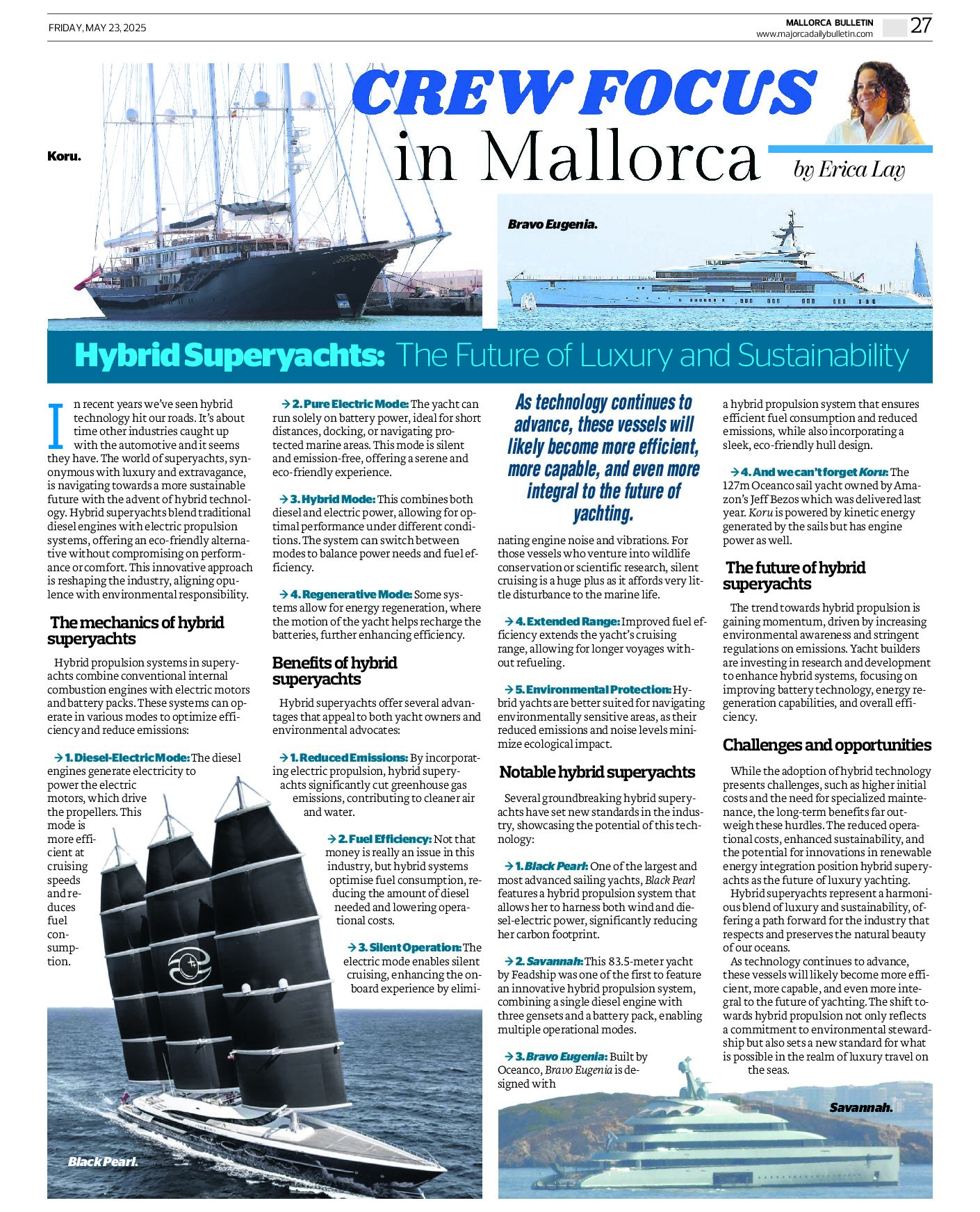Hybrid Superyachts

With Courtesy of Erica Lay & The Mallorca Bulletin. #25/1004.
Erica Lay owner of EL CREW International Yacht Crew Agency http://www.elcrewco.com/ erica@elcrewco.com
Hybrid Superyachts: The Future of Luxury and Sustainability
In recent years, hybrid technology has transformed the automotive world—and now, it’s making waves in the realm of luxury yachting. As climate consciousness reshapes industries across the board, the superyacht sector—long associated with indulgence and extravagance—is charting a course toward a more sustainable future.
Enter hybrid superyachts: elegant vessels that combine traditional diesel propulsion with electric power to deliver cutting-edge performance while reducing environmental impact. This technological evolution is redefining luxury at sea, seamlessly merging comfort, efficiency, and eco-consciousness.
The Mechanics of Hybrid Superyachts
Hybrid propulsion systems are more than just an upgrade—they’re a complete rethinking of how power is delivered at sea. These systems typically feature a mix of diesel engines, electric motors, and battery banks, with multiple modes of operation designed to adapt to different cruising conditions:
1. Diesel-Electric Mode:
Diesel engines power generators that produce electricity for the electric motors. This configuration is ideal for steady cruising and improves overall fuel efficiency.
2. Pure Electric Mode:
The yacht operates solely on battery power. Perfect for short distances, docking, or traversing marine sanctuaries, this mode is both silent and emission-free.
3. Hybrid Mode:
A blend of diesel and electric power, this flexible mode adjusts to optimize performance and fuel consumption dynamically.
4. Regenerative Mode:
In some systems, energy can be recaptured during operation—such as through propeller movement while under sail—to recharge onboard batteries, further increasing sustainability.
Benefits of Hybrid Superyachts
Hybrid systems bring a host of advantages, appealing not just to environmentally aware owners, but also to those seeking a smoother, quieter onboard experience:
Reduced Emissions:
Electric propulsion significantly cuts greenhouse gases and particulate matter, leading to cleaner oceans and air.
Fuel Efficiency:
Hybrid systems reduce reliance on diesel, which means fewer refueling stops and lower running costs—even if money isn’t the issue, it’s a smart move.
Silent Cruising:
Operating in electric mode eliminates engine noise and vibration, enhancing onboard tranquility. For yachts involved in research or conservation, silent cruising is essential to minimize disturbance to marine life.
Extended Range:
Better fuel economy translates into longer voyages without needing to refuel—an invaluable benefit for exploration-focused owners.
Eco-Friendly Access:
Hybrid yachts are ideal for entering environmentally sensitive areas, thanks to reduced noise and emissions.
Notable Hybrid Superyachts
Several pioneering vessels have demonstrated what’s possible when cutting-edge engineering meets sustainability:
Black Pearl:
A true marvel, Black Pearl is one of the largest sailing yachts in the world, harnessing both wind and diesel-electric power to achieve minimal environmental impact.
Savannah (Feadship):
This 83.5-meter hybrid features a combination of a diesel engine, three gensets, and a battery pack—allowing her to operate in multiple configurations for maximum efficiency.
Bravo Eugenia (Oceanco):
With a hybrid system and a streamlined hull, Bravo Eugenia was designed with sustainability in mind from the keel up.
Koru:
Owned by Jeff Bezos, this 127m Oceanco sailing yacht blends kinetic sail power with engine backup, offering a modern homage to traditional maritime propulsion.
The Road Ahead
The hybrid revolution in yachting is gaining momentum—driven by regulatory pressure, owner preferences, and a global shift toward environmental responsibility. Yacht builders are now investing heavily in battery technology, smarter energy management systems, and renewable energy integration, from solar arrays to hydrogen fuel cells.
Challenges and Opportunities
Yes, hybrid systems come with challenges: higher upfront costs, a learning curve for crew, and the need for specialized maintenance. But the rewards—lower emissions, reduced fuel usage, and the prestige of owning a next-generation vessel—are transforming these challenges into opportunities.
Hybrid superyachts are no longer just an innovation—they are a movement. A fusion of luxury and sustainability, they reflect a new era in yachting where environmental stewardship and refined living are no longer at odds. As this technology matures, expect hybrid vessels to become the gold standard in the industry, inspiring a future where the pleasures of the sea can be enjoyed without compromising its health.
